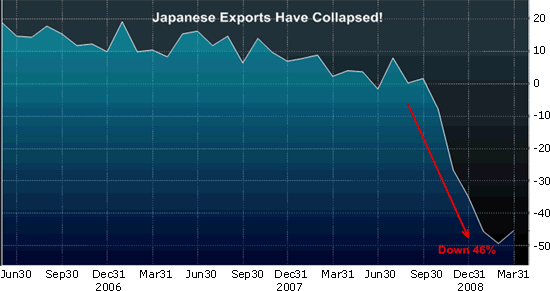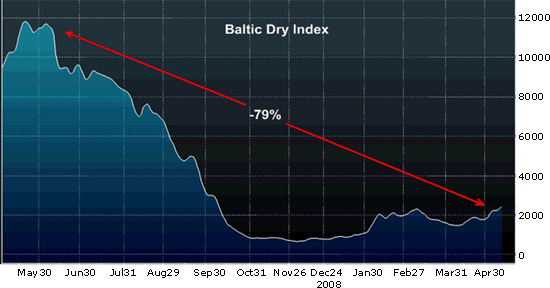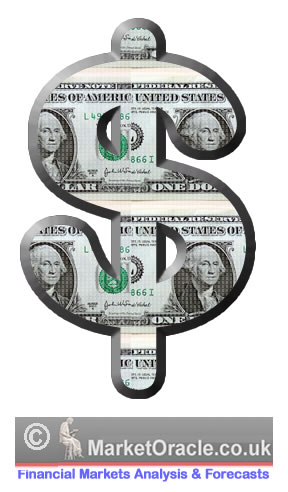The Incredible Shrinking Global Economies Bullish for the U.S. Dollar
Currencies / US Dollar May 17, 2009 - 02:49 PM GMT Bryan Rich writes: Germany is the world’s largest exporter. And in the broadest global recession on record, demand for its exports has come to a virtual standstill.
Bryan Rich writes: Germany is the world’s largest exporter. And in the broadest global recession on record, demand for its exports has come to a virtual standstill.
As a result, Germany, the core of the Eurozone, is shrinking at a record pace. And Germany isn’t alone. Many of the world’s largest economies have rested on the export model.
Americans became dependent upon overconsumption and leverage, and world economies became dependent upon supplying American demand. And now that that demand has dried up, the pain is playing out across economies, especially in Asia.
Take Japan for instance. In Japan, exports make up 17 percent of their economy. In total, the country’s exports are down 46 percent from this time last year. And its all-important auto exports to the U.S., Japan’s biggest customer, are down an astounding 76 percent!

Source: Bloomberg
As a result, Japan’s economy is contracting at an annual rate of 12 percent. That means we’re on pace to see the second largest economy of the world lose 12 percent of its value in a year.
Other export-driven economies in Asia are spiraling downward, too. Singapore is contracting at 20 percent a year; Thailand is contracting at 22 percent.
Exports are king in Asia and account for:
- As much as two-thirds of the GDP in Hong Kong and Singapore,
- Almost half of the output of Malaysia and Thailand,
- And one-third of the output for South Korea and Taiwan.
What about China, the world’s factory?
Goldman Sachs recently upgraded the growth outlook on China. They expect China to grow at more than 8 percent this year. Still shy of the numbers they were putting up over the past several years, but above the 6 percent area that is said to be the equivalent of recession for the Chinese economy.
 |
| China’s $586 billion stimulus package attempts to revive exports rather than domestic demand — worsening its global imbalance problem. |
However, it’s widely known that reporting out of China is not exactly reliable …
In reality, conditions in China are far from good. Exports are down 22 percent. Economist.com estimates that between one-third and one-half of all of the factories in China have closed in the past year.
China has stepped up and rolled out a stimulus package of more than half-a-trillion dollars. But experts suggest that this plan attempts to revive exports rather than domestic demand — exacerbating the global imbalance problem.
Furthermore, China has frontloaded its spending …
More than 80 percent of the allotted stimulus for 2009 is said to have already been spent. So where does that leave the economy for the next seven months? Is China making a bet that the predictions of a late 2009 recovery for the U.S. are going to materialize? If so, they could be in for a rude awakening.
And so could those who think China is going to lead the world out of recession. Indeed, recent energy consumption in China, a good indicator of economic activity, fell 3.5 percent in April from a year ago.
Global Demand Tumbling …
Take a look at the following chart of the Baltic Dry Index, which measures the price customers pay to have raw materials shipped. It’s a good gauge of global demand and of future economic activity. From its peak in May of 2008, the index is down 79 percent.

Source: Bloomberg
This chart shows precisely why export dependent economies are having such a hard time.
It’s common sense: An export driven economy can’t recover without global demand. Right now, global demand has evaporated.
China, for instance, is an economy dominated by cheap labor and low margins in producing commoditized goods. Not exactly a sustainable economic model, nor one with the legs, at this stage, to morph into a more sophisticated economy.
What’s more, the IMF’s study on historical recessions that share the two common features of this recession, global synchronization and financial crisis, suggests that the U.S. is only a third of the way through this recession. So economies expecting to recover from resurgence in demand from the U.S. have a long way to wait.
The more plausible answer is that world economies will have to fix themselves. They will have to endure the pain of slowly rebalancing their economies.
Global rebalancing means we’re all in a rebuilding period. A period where more sustainable independent economies are developed. And in the process a more sustainable and efficient global economy is developed, too.
Trade surplus countries will have to focus on domestic demand. And trade deficit countries will be rebuilding the production model and improving innovation.
 |
| I expect the dollar to get stronger as the visibility of a global recovery becomes more and more cloudy. |
In a Highly Synchronized Global Recession, Imbalanced Economies are Becoming a Threat …
According to the World Bank, government officials around the world have proposed more than 60 new trade restrictions since the beginning of the financial crisis. In a downward spiraling economy, governments embrace these types of protectionist policy decisions to try and protect employment and generate internal economic activity.
But history shows, these are exactly the type of actions that make recessions worse and longer! In fact, trade barriers enacted during the Great Depression resulted in a 33 percent decline in global trade.
So what does all this mean for currencies?
It likely means currency devaluations for those exporting countries that are struggling to find demand. And I expect to see a stronger dollar, as the visibility of a global recovery becomes more and more cloudy.
Regards,
Bryan
This investment news is brought to you by Money and Markets . Money and Markets is a free daily investment newsletter from Martin D. Weiss and Weiss Research analysts offering the latest investing news and financial insights for the stock market, including tips and advice on investing in gold, energy and oil. Dr. Weiss is a leader in the fields of investing, interest rates, financial safety and economic forecasting. To view archives or subscribe, visit http://www.moneyandmarkets.com .
Money and Markets Archive |
© 2005-2022 http://www.MarketOracle.co.uk - The Market Oracle is a FREE Daily Financial Markets Analysis & Forecasting online publication.



